凤凰职教第三册unit1教案
- 格式:doc
- 大小:122.00 KB
- 文档页数:19
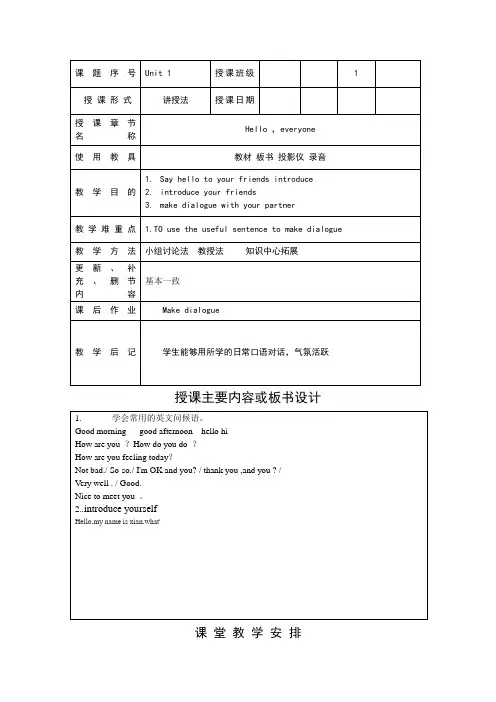
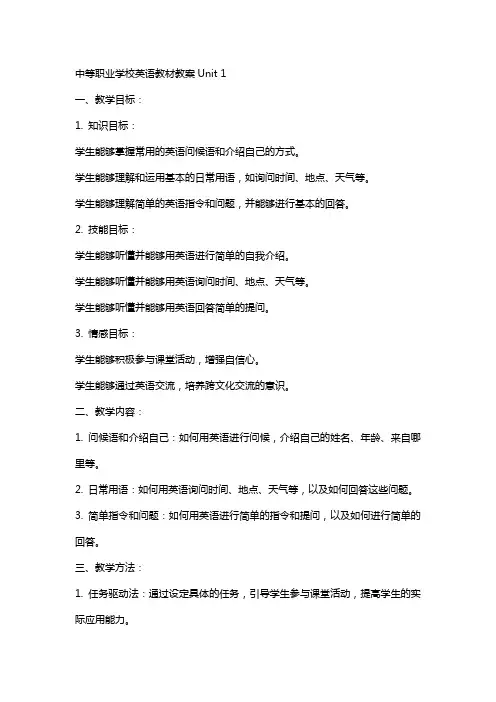
中等职业学校英语教材教案Unit 1一、教学目标:1. 知识目标:学生能够掌握常用的英语问候语和介绍自己的方式。
学生能够理解和运用基本的日常用语,如询问时间、地点、天气等。
学生能够理解简单的英语指令和问题,并能够进行基本的回答。
2. 技能目标:学生能够听懂并能够用英语进行简单的自我介绍。
学生能够听懂并能够用英语询问时间、地点、天气等。
学生能够听懂并能够用英语回答简单的提问。
3. 情感目标:学生能够积极参与课堂活动,增强自信心。
学生能够通过英语交流,培养跨文化交流的意识。
二、教学内容:1. 问候语和介绍自己:如何用英语进行问候,介绍自己的姓名、年龄、来自哪里等。
2. 日常用语:如何用英语询问时间、地点、天气等,以及如何回答这些问题。
3. 简单指令和问题:如何用英语进行简单的指令和提问,以及如何进行简单的回答。
三、教学方法:1. 任务驱动法:通过设定具体的任务,引导学生参与课堂活动,提高学生的实际应用能力。
2. 情景教学法:通过创设真实的语境,让学生在实际情境中学习和使用英语。
3. 互动教学法:通过教师与学生、学生与学生之间的互动,激发学生的学习兴趣和积极性。
四、教学步骤:1. 热身活动:教师与学生用中文进行简单的自我介绍,引导学生用英语进行自我介绍。
2. 教学新知识:教师展示一些常用的英语问候语和介绍自己的方式,引导学生进行学习和模仿。
3. 实践环节:教师创设一些实际情境,如询问时间、地点、天气等,让学生进行实际操作和练习。
4. 总结和反馈:教师对学生的表现进行总结和评价,鼓励学生积极参与课堂活动。
五、课后作业:1. 复习本节课所学的英语问候语和介绍自己的方式。
2. 练习用英语询问时间、地点、天气等,并能够进行回答。
3. 准备下一节课所需带的教材和资料。
中等职业学校英语教材教案Unit 6六、教学目标:1. 知识目标:学生能够掌握有关日常生活中的常见场景的英语表达方式,如餐厅、医院、机场等。
学生能够理解和运用基本的英语句子结构,如主语+谓语+宾语。
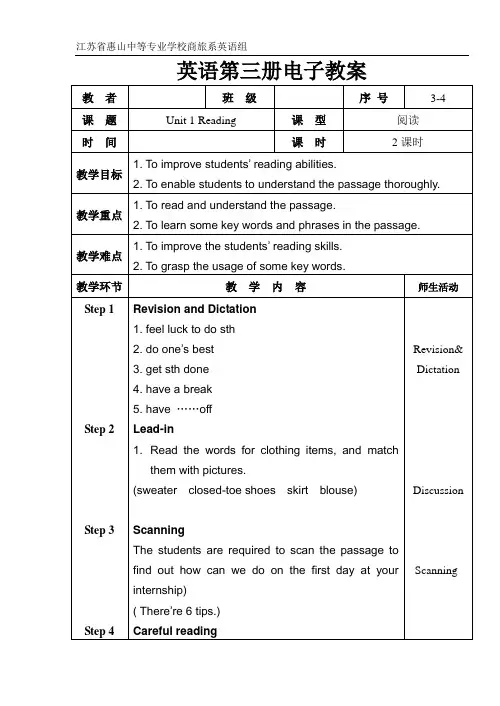

Book 3Unit 1 he decided to have a big Christmas party.一、学情分析本单元是学生第三学年的第一单元,话题与传统节假日相关。
而学生刚从假期中归来,仍沉浸在假期的快乐中。
第一单元的话题非常符合学生的兴趣和当时的心情,这为本单元的学习打下了良好的基础。
第一单元的教学内容主要为:能识别西方传统节日名称并根据听到的信息对节日庆祝活动排序。
能从介绍节日经历的文章中提取关于节日、节日活动的信息。
能用关键词描述简单的节日活动,能够描述自己参加节日庆祝的经历。
本单元的话题虽然亲切,教师仍然要注意运用多种教学手段,并关注每一个学生,在一些教学步骤中采用分层设计,帮助学生达成教学目标。
本单元设计分为4个课时:第一课时 lead-in + listening and speaking第二课时 reading and writing第三课时 language in use + unit task第四课时 self-check + words and expressions + life and culture第一课时 Lead-in + Listening & Speaking二、教材分析1. 教学内容本课时系教材《英语3》(基础模块高教版)第一单元的第一课时,包括Lead-in & Listening and speaking两部分,具体内容为:能够听懂并谈论家庭在假期中的活动,掌握提供以及询问过去的经历的词汇和句型。
2. 教学重点、难点⑴教学重点培养学生在听的过程中把握对话主旨的能力。
了解西方传统节日的主要特点,并学习相关词汇。
⑵教学难点熟练掌握邀请等的词汇和句型三、教学目标1. 知识目标⑴帮助学生掌握以下词汇:如festival, delicious, dress, celebrate, prefer, share, ghost, freeze, sight.等⑵帮助学生掌握发出邀请所使用的词组和句型,如:Have fun, invite, get ready for, go on, dress up, enjoy, prepare…for…., share…. With, be covered with, in public.Would you like to go to…. With me ?Would you like to join us?It sounds interesting but I prefer to……, “I think I will.”2. 能力目标⑴了解西方传统节日的主要特点⑵学生能在听的过程中把握对话主旨的能力。

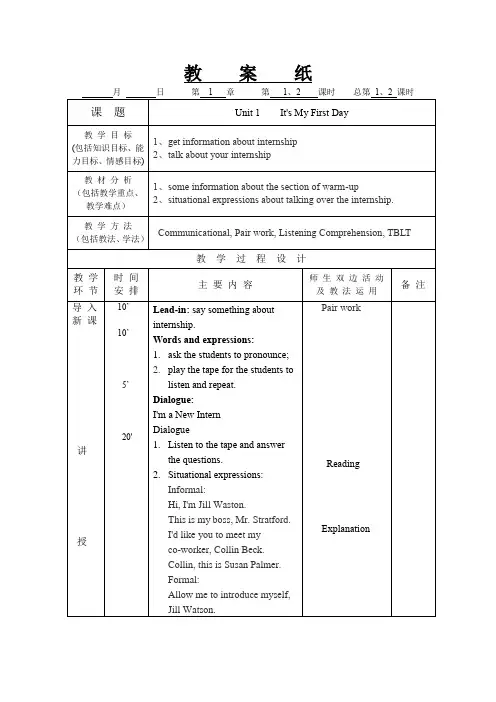

II. Discuss with your partner the meaning of
the signs below.
1.
Be careful of the slippery surface.
2.
No smoking here.
3.
First aid station.
4.
Fire alarm.
Step Two: Listening A Work-related Injuries Activity 1: Listen to the conversation and tick the posture the man usually adopts at work.
Look at how you are slouching over your keyboard.
Activity 2: Listen again. Then underline the causes of injuries to the man.通过图形、颜色以及日常
生活经验,用正确的语句
表达每一个标志的含义
Look at the picture &
listen to the tape
Listen & Underline
为听说部分
提供词汇和
句型的保障。
听对话录音,
根据对话内
容辨析所匹
配的图片。
再听对话录
音,根据对话
中人物的语
音、语调及对
话的内容判
断在日常工
作和生活中,
不正确的姿
-----精心整理,希望对您有所帮助!。
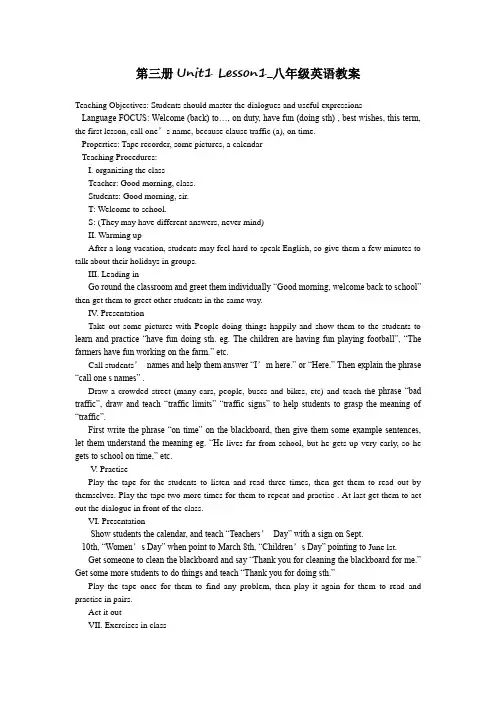
第三册Unit1 Lesson1_八年级英语教案Teaching Objectives: Students should master the dialogues and useful expressionsLanguage FOCUS: Welcome (back) to…, on duty, have fun (doing sth) , best wishes, this term, the first lesson, call one’s name, because clause traffic (a), on time.Properties: Tape recorder, some pictures, a calendarTeaching Procedures:I. organizing the classTeacher: Good morning, class.Students: Good morning, sir.T: Welcome to school.S: (They may have different answers, never mind)II. Warming upAfter a long vacation, students may feel hard to speak English, so give them a few minutes to talk about their holidays in groups.III. Leading inGo round the classroom and greet them individually “Good morning, welcome back to school” then get them to greet other students in the same way.IV. PresentationTake out some pictures with People doing things happily and show them to the students to learn and practice “have fun doing sth. eg. The children are having fun playing football”, “The farmers have fun working on the farm.” etc.Call students’names and help them answer “I’m here.” or “Here.” Then explain the phrase “call one s names” .Draw a crowded street (many cars, people, buses and bikes, etc) and teach th e phrase “bad traffic”, draw and teach “traffic limits” “traffic signs” to help students to grasp the meaning of “traffic”.First write the phrase “on time” on the blackboard, then give them some example sentences, let them understand the meaning eg. “H e lives far from school, but he gets up very early, so he gets to school on time,” etc.V. PractisePlay the tape for the students to listen and read three times, then get them to read out by themselves. Play the tape two more times for them to repeat and practise . At last get them to act out the dialogue in front of the class.VI. PresentationShow students the calendar, and teach “Teachers’Day” with a sign on Sept.10th, “Women’s Day” when point to March 8th, “Children’s Day” pointing to June lst.Get someone to clean the blackboard and say “Thank you for cleaning the blackboard for me.” Get some more students to do things and teach “Thank you for doing sth.”Play the tape once for them to find any problem, then play it again for them to read and practise in pairs.Act it outVII. Exercises in classFill in the blanks1. Welcome back ________School.2. The boys always have fun ____ basketball (play).3. The students say “here”____ the teacher call their names.4. Mary always gets to school ____ time.5. I m not ____ duty today.6. I made a card ____ my friend Tom.7. Thank you ____ your coming to see me.Answers: 1.to, 2.playing, 3.when, 4.on, 5.on, 6.for, 7.for.VIII. Homework1. To make a card for your teacher, parents or friends.2. To make sentences with: have fun (doing sth) on time, welcome …toIX. SummaryLi FupengLesson 1Teaching Objectives: Students should master the dialogues and useful expressionsLanguage FOCUS: Welcome (back) to…, on duty, have fun (doing sth) , best wishes, this term, the first lesson, call one’s name, because clause traffic (a), on time.Properties: Tape recorder, some pictures, a calendarTeaching Procedures:I. organizing the classTeacher: Good morning, class.Students: Good morning, sir.T: Welcome to school.S: (They may have different answers, never mind)II. Warming upAfter a long vacation, students may feel hard to speak English, so give them a few minutes to talk about their holidays in groups.III. Leading inGo round the classroom and greet them individually “Good morning, welcome back to school” then get them to greet other students in the same way.IV. PresentationTake out some pictures with People doing things happily and show them to the students to learn and practice “have fun doing sth. eg. The children are having fun playing football”, “The farmers have fun working on the farm.” etc.Call students’names and help them answer “I’m here.” or “Here.” Then explain the phrase “call one s names” .Draw a crowded street (many cars, people, buses and bikes, etc) and teach the phrase “bad traffic”, draw and teach “traffic limits” “traffic signs” to help students to grasp the meaning of “traffic”.First write the phrase “on time” on the blackboard, then give them some example sentences, let them understand the meaning eg. “He lives far from school, but he gets up very early, so he gets to school on time,” etc.V. PractisePlay the tape for the students to listen and read three times, then get them to read out bythemselves. Play the tape two more times for them to repeat and practise . At last get them to act out the dialogue in front of the class.VI. PresentationShow students the calendar, and teach “Teachers’Day” with a sign on Sept.10th, “Women’s Day” when point to March 8th, “Children’s Day” pointing to June lst.Get someone to clean the blackboard and say “Thank you for cleaning the blackboard for me.” Get some more students to do things and teach “Thank you for doing sth.”Play the tape once for them to find any problem, then play it again for them to read and practise in pairs.Act it outVII. Exercises in classFill in the blanks1. Welcome back ________School.2. The boys always have fun ____ basketball (play).3. The students say “here”____ the teacher call their names.4. Mary always gets to school ____ time.5. I m not ____ duty today.6. I made a card ____ my friend Tom.7. Thank you ____ your coming to see me.Answers: 1.to, 2.playing, 3.when, 4.on, 5.on, 6.for, 7.for.VIII. Homework1. To make a card for your teacher, parents or friends.2. To make sentences with: have fun (doing sth) on time, welcome …toIX. SummaryLesson 104教学设计示例一、教学目标1.知识目标(1)掌握字母组合th,sh,wh的发音。
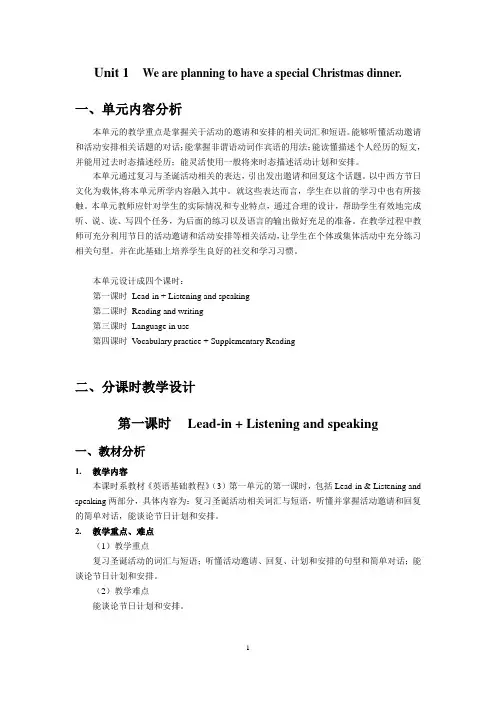
Unit 1 We are planning to have a special Christmas dinner.一、单元内容分析本单元的教学重点是掌握关于活动的邀请和安排的相关词汇和短语。
能够听懂活动邀请和活动安排相关话题的对话;能掌握非谓语动词作宾语的用法;能读懂描述个人经历的短文,并能用过去时态描述经历;能灵活使用一般将来时态描述活动计划和安排。
本单元通过复习与圣诞活动相关的表达,引出发出邀请和回复这个话题。
以中西方节日文化为载体,将本单元所学内容融入其中。
就这些表达而言,学生在以前的学习中也有所接触。
本单元教师应针对学生的实际情况和专业特点,通过合理的设计,帮助学生有效地完成听、说、读、写四个任务,为后面的练习以及语言的输出做好充足的准备。
在教学过程中教师可充分利用节日的活动邀请和活动安排等相关活动,让学生在个体或集体活动中充分练习相关句型。
并在此基础上培养学生良好的社交和学习习惯。
本单元设计成四个课时:第一课时Lead-in + Listening and speaking第二课时Reading and writing第三课时Language in use第四课时V ocabulary practice + Supplementary Reading二、分课时教学设计第一课时Lead-in + Listening and speaking一、教材分析1.教学内容本课时系教材《英语基础教程》(3)第一单元的第一课时,包括Lead-in & Listening and speaking两部分,具体内容为:复习圣诞活动相关词汇与短语,听懂并掌握活动邀请和回复的简单对话,能谈论节日计划和安排。
2.教学重点、难点(1)教学重点复习圣诞活动的词汇与短语;听懂活动邀请、回复、计划和安排的句型和简单对话;能谈论节日计划和安排。
(2)教学难点能谈论节日计划和安排。
二、教学目标1.知识目标(1)学习并识记谈论节日活动的词汇与短语,如:send gifts wrapped in colorful paperbuy and decorate a Christmas treedo something fun with your family outdoorsinvite your friends or relatives over for Christmas dinnerhold a Christmas partysing Christmas songsdo the annual housecleaningget together for a mealget lucky moneyvisit relatives and friends(2)学会并能套用谈论节日活动计划和安排的句型,如:Do you have any plan for this Spring Festival?I am planning to….Why not come and join us?I’d love to, but…How about …?I’m looking forward to…2.能力目标(1)能听懂关于活动邀请、回复、计划和安排的句型和简单对话。
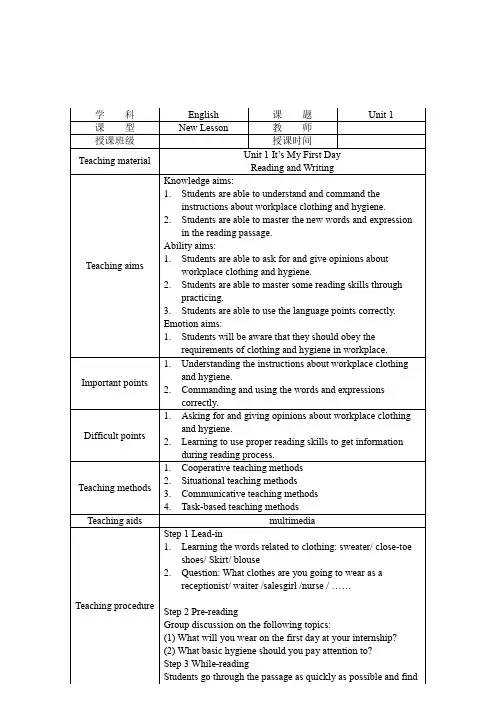
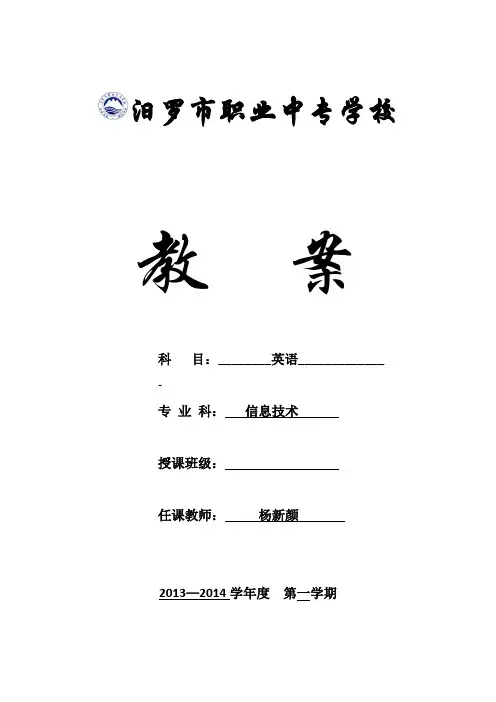
综合英语(3)课程教案综合英语(3)课程教案way (指人)做事敷衍塞责的. > perfunctorily/ -trəlɪ; -tərəlɪ/ adv: check the luggage perfunctorily对行李作例行的检查. perfunctoriness n [U].regime n (a) method or system of government 统治方式或制度; 政体; 政权: a socialist, fascist, etc regime社会主义﹑法西斯等制度. (b) prevailing method or system of administration (eg in a business) 盛行的管理方式或制度(如商业中的): changes made under the present regime 现行管理方法带来的变化* the old regime versus the new新管理制度对旧管理制度.underpin v (-nn-) [Tn]support (a wall, etc) from below with masonry, etc 用砖石结构等从下面支撑(墙等); 加固(墙等)的基础.(fig 比喻) form the basis for (an argument, a claim, etc); strengthen 为(论据﹑主张等)打下基础; 加强; 巩固: The evidence underpinning his case was sound. 有利於他的证据是确凿的. * These developments are underpinned by solid progress in heavy industry. 重工业的稳固发展为这些进展打下了基础.Difficult sentences:1. Since China formally joined the World Trade Organization in November 2001. its economy has continued growing strongly and attracting much foreign investment, while the world’s major economies have struggled with sluggish growth or recession.自2001年11月正式加入世界贸易组织后,中国经济持续强势发展,吸引了大量的外资,而世界的主要经济实体却在缓慢增长或萎缩中挣扎。
学时教学内容Unit1 He decided to have a big chrisstmas party Langguagein use课型节次授课班级授课日期出勤情况纪律情况知识与技能过程与方法情感态度价值观教学目的1、使学生了解非谓语动词作宾语的形式2、使学生明白那些动词后面可以接to do 的形式3、使学生明白那些动词后面接doing 的形式1、复习旧知识2、导入新知识3、学习新知识4、巩固练习讲授法讨论法使学生喜爱说英语,乐于开动脑筋思考英语问题教学重点非谓语动词作宾语的用法教学难点区分那些动词后面接to do 的形式那些动词后面接doing 的形式有些动词既可以接to do,也可以接doing ,两者之间的区别教学资源多媒体课件教学后记教学程序重、难点诠释、教学方法等Step1 Warm up1、Sing a song2、Greeting3、复习之前所学习的词和词组,celebrate,festival,delicious,dress,dressup,ghost,prefer,prefer to,share with,be covered with Hunt for ,freeze,have/hold parties,invite sb to do sthStep 2 lead inGrammar focus / Read and group1、呈现我们之前学过的课文的有关句子,并询问他们为什么有的动词后面接to do 的形式,有的动词接doing 的形式,以引起学生的思考。
It sounds interesting but i prefer to stay at home .We can start prefaring for the Hallween party tomorrow.That's very kind of you ,but i hate telling stories.2让学生做15的练习,然后师生一起核对答案,3、教师给出学生更多的例子,让学生造句,使学生大致了解其用法。
Unit 1 We are planning to have a special Christmas dinner.第二课时Reading and writing一、教材分析1.教学内容本课内容是《英语基础教程》(3)第一单元的第二课时,包括Reading and writing部分,具体内容为:阅读关于圣诞节特别经历的短文,能够读懂短文所描述的内容并能掌握如何讲述过去发生的事情。
2.教学重点、难点(1)教学重点理解描述个人经历的短文;根据故事六要素复述短文内容。
(2)教学难点准确地描述个人经历,复述短文内容。
二、教学目标1.知识目标(1)学习文章相关的词汇与短语,如:please prefer while instead of be hard to do sth. except for drive up come across get sick ofthink of…….(2)重点句型,如:be hard to do sth. prefer to do sth. be busy doing sth. 2.能力目标(1)能读懂描述个人经历的短文。
(2)能根据故事六要素复述短文内容。
(3)能准备描述个人经历。
3.情感目标(1)让学生掌握描述个人经历的方法,培养学生乐于分享自己的情感和经历的习惯,增强人际沟通能力。
通过小组协作培养学生团队协作能力!(2)培养学生在日常生活中运用英语的习惯,提高他们对英语学习的兴趣和英语的重复使用率。
三、教学方法:Teaching in groups task-based四、教学准备:Computer PPT textbook radios五、教学步骤Step One Warming upAll the Ss say “This second doesn’t give up, the next second is hopeful! Go! Go! Go!”Step two Lead-in1.Show thesome pictures of Christmas. Ask Ss to answer my questions and talkabout what do people usually do on Christmas Day?(设计意图:检查学生预习情况,复习所学单词与短语。
please可以请您把盐瓶子递过来吗
B:—With pleasure!当然可以! With pleasure与All right, No problem. I’d like to等习语意义相同。
用于别人求你做某事,你很乐意去做的时候。
例如:
-Could you post the letter for me
-With pleasure.
-你能否替我把这封信寄走-愿意效劳。
简单讲,It’s a pleasure用于事情发生之后,而with pleasure 用于事情发生之前。
My pleasure.是相当正式的说法,意思是“我的荣幸之至”。
你可以把它想成是It has been my pleasure to help you.(能够帮助你是我的荣幸。
)的省略结果。
这个句子还能有如下的用法:-"I'm glad to meet you.""The pleasure is all mine."("很高兴认识你。
""哪里,我才是呢。
")
- "Could you help me for a minute""My pleasure."("你可以帮我一下吗""我很乐意。
")
it's my pleasure=my pleasure 荣幸之至。